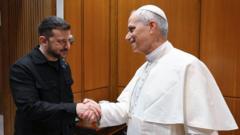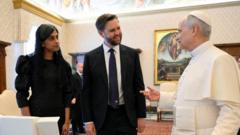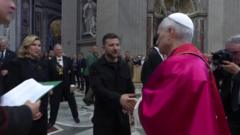Vatican City witnesses a blend of historical ritual and contemporary practices as the selection of a new pope captivates the world.
**The Vatican's Smoke Signals: Tradition Meets Modernity in Papal Elections**

**The Vatican's Smoke Signals: Tradition Meets Modernity in Papal Elections**
An age-old custom continues as white and black smoke signals the decision of cardinals in the Sistine Chapel.
Historically rooted in the 19th century, the ritual of signaling the election of a new pope with colored smoke from the Sistine Chapel chimney remains a hallmark of papal conclaves today. When cardinals gather behind the chapel's hallowed walls to cast their votes, the anticipation builds among spectators in St. Peter’s Square, awaiting either a plume of white smoke—which signifies the election of a new pope—or black smoke, which indicates that no decision has yet been reached.
Frederic J. Baumgartner, in his detailed exploration "Behind Locked Doors," traces the origins of this custom to the 1823 conclave; however, it has evolved significantly since then. Initially, the ashes of the ballots and notes of the cardinals were simply burned, but by the 20th century, wet straw was incorporated to produce a distinct white smoke. Unfortunately, this method proved unreliable at times, leading to confusion—most notably during the 1958 conclave when white smoke unexpectedly appeared, signaling nothing had been decided.
Voting takes place over several rounds, with each ballot being incinerated after two votes are cast unless a pope is confirmed. This modernization ensures clarity and accuracy, reflecting the Vatican's commitment to maintaining traditions while adapting to contemporary needs. The smoke signals serve not merely as announcements but as sacred markers in a storied ceremony that continues to hold deep religious significance while adapting to the ever-changing landscape of global communication.
Frederic J. Baumgartner, in his detailed exploration "Behind Locked Doors," traces the origins of this custom to the 1823 conclave; however, it has evolved significantly since then. Initially, the ashes of the ballots and notes of the cardinals were simply burned, but by the 20th century, wet straw was incorporated to produce a distinct white smoke. Unfortunately, this method proved unreliable at times, leading to confusion—most notably during the 1958 conclave when white smoke unexpectedly appeared, signaling nothing had been decided.
Voting takes place over several rounds, with each ballot being incinerated after two votes are cast unless a pope is confirmed. This modernization ensures clarity and accuracy, reflecting the Vatican's commitment to maintaining traditions while adapting to contemporary needs. The smoke signals serve not merely as announcements but as sacred markers in a storied ceremony that continues to hold deep religious significance while adapting to the ever-changing landscape of global communication.




















